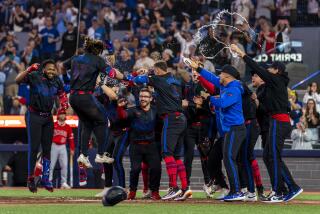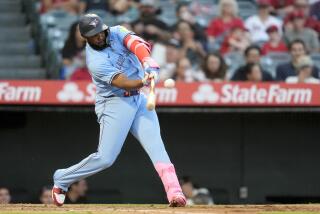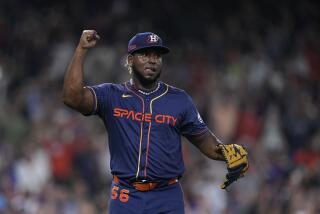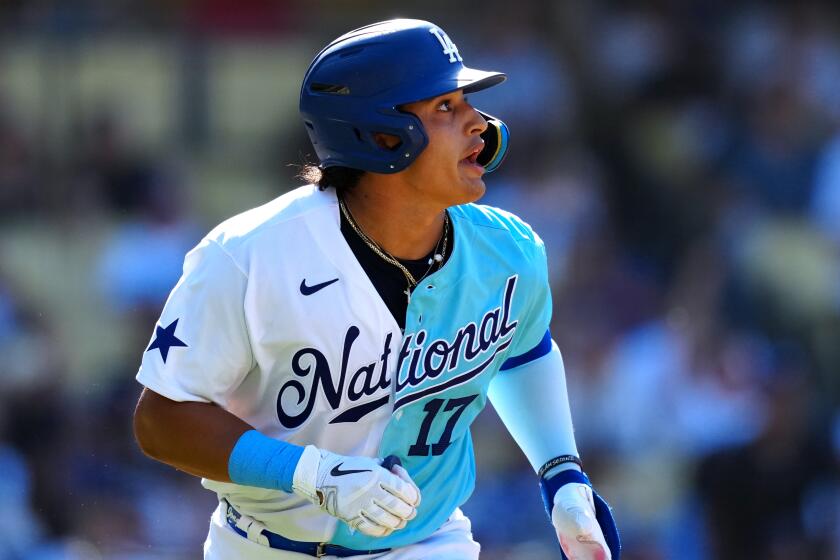Toronto Emerges as City of Long-Ball Hitters
TORONTO — In Los Angeles and Baltimore, they manufacture pitchers. In St. Louis, shortstops roll off the assembly line. In Boston, left fielders come cranking out.
But baseball’s biggest factory these days is in Toronto. It’s the Blue Jays’ power plant.
First it was Jesse Barfield, who led the majors with 40 home runs in 1986. Then George Bell hit 47 in 1987. Last season, Fred McGriff topped the American League with 36 homers.
This year, Kelly Gruber is second in the big leagues with 10 home runs. He trails only Detroit’s Cecil Fielder, who, naturally enough, rose through Toronto’s minor league system but left the Blue Jays after the 1988 season because he couldn’t break into the starting lineup.
So with every team in the major leagues searching desperately for sluggers, how come the Blue Jays always seem to find them?
“There was never any intention to actually look for a home-run hitter back in the early ‘80s,” Blue Jays assistant general manager Gord Ash said. “The fact that this club has produced that type of player stems more from our policy, which was to draft the best available athlete.”
That’s how Boston maintained its long line of left fielders, which started in the late 1930s with Ted Williams, continued through Carl Yastrzemski and Jim Rice, and now is carried on by Mike Greenwell. The Cardinals became shortstop-crazy with Jose Uribe, Rafael Santana and Jose Oquendo growing up in their organization, but none beating out Ozzie Smith.
The Dodgers have produced pitchers like Sandy Koufax, Don Sutton and Orel Hershiser. The Orioles have done well with Jim Palmer, Dave McNally and Scott McGregor, to name a few.
Gruber, who hit a career-high 18 home runs last year, was drafted from the Cleveland organization after the 1983 season.
If Gruber could win the league home-run title, it would give Toronto three different champions in five years. That hasn’t happened in the AL in the span of five full seasons since 1939-43, when Williams, Jimmie Foxx and Rudy York did it for Boston.
The last time any team produced three home-run champions in such a short time was 1961-63, when Willie Mays, Willie McCovey and Orlando Cepeda won titles for San Francisco.
“I’m not about to get into any home run races with Bell or McGriff,” Gruber said. “I’m not a home run hitter and I don’t get paid to hit them. My job is to hit the ball hard. If I do that, the home runs will come.”
The home runs are now coming for all the Blue Jays, who lead the majors with 42 in 28 games. Bell is second on the team with six, McGriff and Pat Borders (in only 52 at-bats) are next with five. John Olerud has hit four and fellow rookie Glenallen Hill has three.
Last year, Hill hit 21 home runs at Class AAA Syracuse. Julian Yan led the Blue Jays’ system with 24 homers at Class A Dunedin and Pedro Munoz had 19 for Double-A Knoxville.
And more home runs are likely, now and in the future. After all those panicky, early reports last year that the SkyDome was a pitcher’s park, Toronto’s home is turning out to be a homer haven, after all.
Of the Blue Jays’ 42 home runs, 34 have been hit at home. All 10 of Gruber’s shots have come at the SkyDome.
“Every player likes hitting at home,” Gruber said. “Besides, the wind is never blowing in. The weather is always good.”
That wasn’t true at Exhibition Stadium, the only place the Blue Jays had played before moving last June. There, tricky winds off Lake Ontario were as common as the ever-present seagulls.
But so were home runs.
“I don’t think there is any question that Exhibition Stadium was a hitter’s park,” Ash said. “But Bell and Barfield are true sluggers with the ability to hit the ball out of any park. I don’t think it’s fair to say the stadium was the reason for their high totals.”
After several seasons in which aging veterans like Ron Fairly and John Mayberry had led the expansion Blue Jays in homers, Toronto began to produce its own power five years later in 1982. That when Barfield, a little known right fielder, hit 18 homers in 395 at-bats to become the team’s first home-grown home-run hitter.
Barfield hit 27 homers in 1983 to tie Willie Upshaw, another draft pick, for the club lead.
In that same season, Bell, who had been drafted from Philadelphia’s system, joined Barfield and Lloyd Moseby to form what would eventually become one of the most formidable outfields of the ‘80s.
“Players like Bell and Barfield were a direct result of our draft policy,” Ash said. “The intention of the club was to draft positional players in the early years. Moseby, Barfield, Upshaw and Bell were all a part of that policy, which didn’t really change until the early ‘80s when pitching became the priority of this club.”
In 1985, the fun really started. Bell and Barfield battled all season for the club lead in homers with Bell eventually coming out on top with 28, to Barfield’s 27.
Barfield really turned on the power in 1986, leading the majors with 40. Bell wasn’t far behind with 31.
In 1987, Bell was the AL’s Most Valuable Players with 47 homers and 134 RBIs. The lively ball may have had something to do with Bell finishing second in the league’s home-run race to Oakland rookie Mark McGwire’s 49.
The Blue Jays had their own rookie at first that season, a tall skinny kid the team had swiped from the New York Yankees. McGriff set a club record with 20 homers in 295 at-bats in 1987.
McGriff was traded with outfielder Dave Collins and pitcher Mike Morgan to the Blue Jays on Dec. 9, 1982, for pitcher Dale Murray and a minor leaguer. At that point, McGriff had played just two seasons in the Gulf Coast League, hitting a total of nine home runs in 298 at-bats.
“When we picked up Fred from the Yankees, he was more or less part of a package. The immediate need for our club was an experienced outfielder. Dave Collins was the guy we were really after,” Ash said. “But again, with McGriff, it was a case of going after the best possible player.”
McGriff hit 34 home runs in 1988 and the doubt had officially been removed as to who the real slugger was in the Blue Jays’ lineup.
“Freddie’s just a natural,” Blue Jays manager Cito Gaston says. “With his arm extension and his strength, he’s ideally suited for hitting home runs. It’s not something you can teach a kid to do. When you’re blessed with the physical ability of a McGriff, hitting home runs is something that just comes naturally to him.”
More to Read
Are you a true-blue fan?
Get our Dodgers Dugout newsletter for insights, news and much more.
You may occasionally receive promotional content from the Los Angeles Times.






